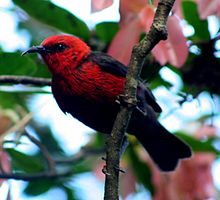- Micronesian Myzomela
-
Micronesian Myzomela 
M. r. saffordi, Saipan Conservation status Scientific classification Kingdom: Animalia Phylum: Chordata Class: Aves Order: Passeriformes Family: Meliphagidae Genus: Myzomela Species: M. rubratra Binomial name Myzomela rubratra
(Lesson, 1827)The Micronesian Myzomela (Myzomela rubratra) is a species of bird in the honeyeater family Meliphagidae. The species forms a superspeices wit a number of related and similar looking island and mainland myzomelas across the Pacific and Australasia. It in turn is composed of seven insular subspecies.
It is distributed throughout the Northern Mariana Islands, including Rota, Tinian and Saipan, as well as Yap, Chuuk, Pohnpei and Kosrae in Micronesia, and the islands of Palau. The species once also occurred in Guam, but that population is now almost certainly extinct.
Across its wide distribution the Micronesian Myzomela occupies a range natural and man-made habitats, from sea-level to the highest peaks, although the lack of mountains in Micronesia predominately make this a species of the lowlands. Forests, mangroves, scrubland, secondary scrub, savanna, agricultural and plantations and urban areas are all used by this species.
The Micronesian Myzomela primarily feeds on nectar, but will also take insects and other small invertebrates. One study estimated that the ratio of nectar to insects was 60:40. They occur singly and in pairs, occasionally small groups will gather at good sources of nectar. They are territorial and aggressive at defending their territories from others of the same species and other species such as Bridled White-eyes. The species is an important pollinator within its range; after its extinction on Guam the island as left without pollinators, with resulting effects on the ecosystem.[2]
References
- ^ BirdLife International (2004). Myzomela rubratra. 2006 IUCN Red List of Threatened Species. Downloaded on 26 July 2007.
- ^ Mortensen, Hanne; Yoko Luise Dupont & Jens M. Olesen (2008). "A snake in paradise: Disturbance of plant reproduction following extirpation of bird flower-visitors on Guam". Biological Conservation 141 (8): 2146–2154. doi:10.1016/j.biocon.2008.06.014.

This article about a honeyeater is a stub. You can help Wikipedia by expanding it.

